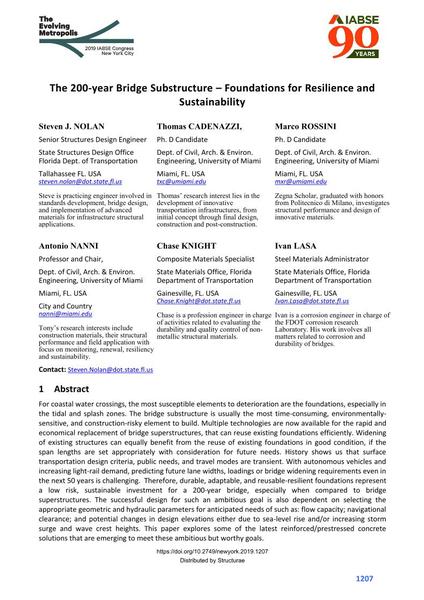The 200-year Bridge Substructure – Foundations for Resilience and Sustainability

|
|
|||||||||||
Détails bibliographiques
| Auteur(s): |
Steven J. Nolan
(State Structures Design Office Florida Dept. of Transportation)
Thomas Cadenazzi (Dept. Of Civil, Arch. & Environ. Engineering, University of Miami) Marco Rossini (Dept. of Civil, Arch. & Environ. Engineering, University of Miami) Antonio Nanni (Dept. of Civil, Arch. & Environ. Engineering, University of Miami) Chase Knight (State Materials Office, Florida Department of Transportation) Ivan Lasa (State Materials Office, Florida Department of Transportation) |
||||
|---|---|---|---|---|---|
| Médium: | papier de conférence | ||||
| Langue(s): | anglais | ||||
| Conférence: | IABSE Congress: The Evolving Metropolis, New York, NY, USA, 4-6 September 2019 | ||||
| Publié dans: | The Evolving Metropolis | ||||
|
|||||
| Page(s): | 1207-1213 | ||||
| Nombre total de pages (du PDF): | 7 | ||||
| DOI: | 10.2749/newyork.2019.1207 | ||||
| Abstrait: |
For coastal water crossings, the most susceptible elements to deterioration are the foundations, especially in the tidal and splash zones. The bridge substructure is usually the most time-consuming, environmentally- sensitive, and construction-risky element to build. Multiple technologies are now available for the rapid and economical replacement of bridge superstructures, that can reuse existing foundations efficiently. Widening of existing structures can equally benefit from the reuse of existing foundations in good condition, if the span lengths are set appropriately with consideration for future needs. History shows us that surface transportation design criteria, public needs, and travel modes are transient. With autonomous vehicles and increasing light-rail demand, predicting future lane widths, loadings or bridge widening requirements even in the next 50 years is challenging. Therefore, durable, adaptable, and reusable-resilient foundations represent a low risk, sustainable investment for a 200-year bridge, especially when compared to bridge superstructures. The successful design for such an ambitious goal is also dependent on selecting the appropriate geometric and hydraulic parameters for anticipated needs of such as: flow capacity; navigational clearance; and potential changes in design elevations either due to sea-level rise and/or increasing storm surge and wave crest heights. This paper explores some of the latest reinforced/prestressed concrete solutions that are emerging to meet these ambitious but worthy goals. |
||||
| Mots-clé: |
ponts
|
||||
